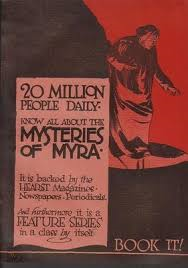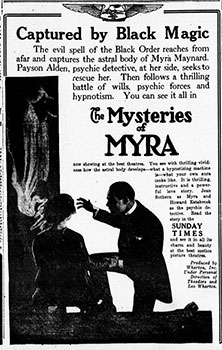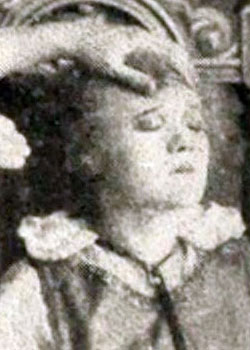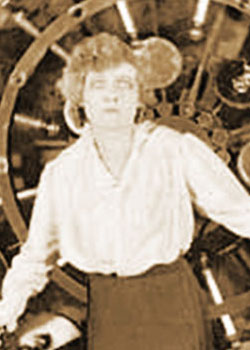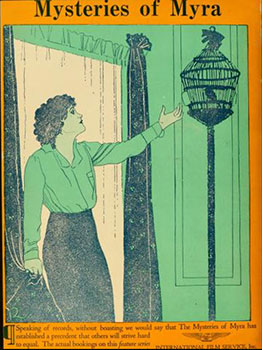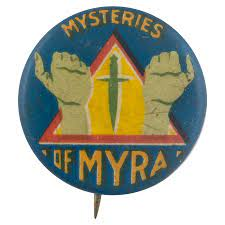M …is for
The Mysteries of Myra
Pioneering in both subject and execution, The Mysteries of Myra aimed to avoid the hackneyed melodramatic lines of many early serials. By offering an entirely different theme, the picture purportedly would demonstrate the way that science had become powerful enough to “prove” the existence of the unscientific. The scenario was written by Charles W. Goddard, a veteran of serial pictures who had scripted The Perils of Pauline (1914) and whose association with the Whartons dated back to their first Elaine serial production. On the Myra scripts, Goddard collaborated closely with Hereward Carrington, the well-known British-born American investigator of psychic phenomena and author of more than a hundred books and pamphlets on subjects ranging from parapsychology, spiritualism, and psychic phenomena to stage magic, alternative medicine, and fasting.
The eponymous heroine Myra Maynard is a sensitive young woman with latent psychic ability that makes her susceptible to the predations of the members of the devil-worshipping Black Lodge, who wish to destroy her. The Lodge’s Grand Master, it seems, has already caused the deaths of her two older sisters. He intends to bring about Myra’s death as well, knowing that if she dies before she reaches her eighteenth birthday, her late father’s fortune will revert to the Black Order that he leads. Scientist and psychic researcher Dr. Payson Alden, Myra’s champion, devotes himself to protecting her from the ongoing interference of Arthur Varney, who pretends to be her friend but is secretly a member of the Lodge.
Alden, though, recovers and continues to subvert the plans of the Master, whose magical hold over Myra remains strong. The Master “absorbs” Myra’s astral body into his own, unleashes a deadly flood, attempts to incinerate Myra, invokes a chant that causes her heart to fail, and places her in a state of suspended animation. When that fails, he summons a “Fire-Elemental” to set ablaze the barge where Myra is hiding and burn her alive. He then conspires with an elderly couple, promising them an elixir of youth if they agree to destroy Myra. Most dangerous of all, though, is the “Thought Monster” that he creates and sets upon the hapless heroine. But when the Monster overhears the Master’s plan to destroy it once its deadly work is done, it turns on the villain and deals him a final and fatal blow, ensuring that Myra and Alden are at last free of him—and, presumably, free to live happily ever afterward.
A production as nontraditional as Myra demanded a vigorous and nontraditional promotion. And that is precisely what Hearst delivered. He peppered his many publications with graphic and colorful ads for the serial. Later novelized by author and director Eustace Hale Ball, the serial also enjoyed various promotional novelty items, from small metal advertising buttons to cardboard masks (now highly collectible). Another popular giveaway was the “Crolette,” a cardboard planchette that purportedly could be manipulated in order to contact the spirit world, much like a mini-Ouija board.
Survival Status: Most of the serial is presumed lost. But, according to Progressive Silent Film List, three episodes (incomplete)—5, 12, and 15—survive in the Library of Congress Film Archive/American Film Institute Collection. One reel of episode 12 can be viewed on YouTube. Episode 12, “The Elixir of Youth” – https://www.youtube.com/watch?v=-ewIpdogU9Q.
Directors: Theodore Wharton, Leopold Wharton
Release Date: August 24, 1916
Release Company: Wharton, Inc., distributed by International Film International Film Company Service, Inc. (Pathé Exchange)
Cast: Jean Sothern (Myra Maynard), Howard Estabrook (Dr. Payson Alden), Allan Murnane (Arthur Varney), M. W. Rale (Master of the Black Order), Shino Mori (Professor Haji), Bessie Wharton (Mrs. Maynard), Elsie Baker (The Vampire Woman), LeRoy Baker (Willis, the Maynards’ Butler), F. W. Stewart, Robin H. Townley, Aleister Crowley.
Episodes: (three reels, with the rest of the episodes in two reels) 1. The Dagger of Dreams. 2. The Poisoned Flower. 3. The Mystic Mirrors. 4. The Wheel of Spirit. 5. The Fumes of Fear. 6. The Hypnotic Clue. 7. The Mystery Mind. 8. The Nether World. 9. The Invisible Destroyer. 10. Levitation. 11. The Fire-Elemental. 12. Elixir of Youth. 13. Witchcraft. 14. Suspended Animation. 15. The Thought Monster.

